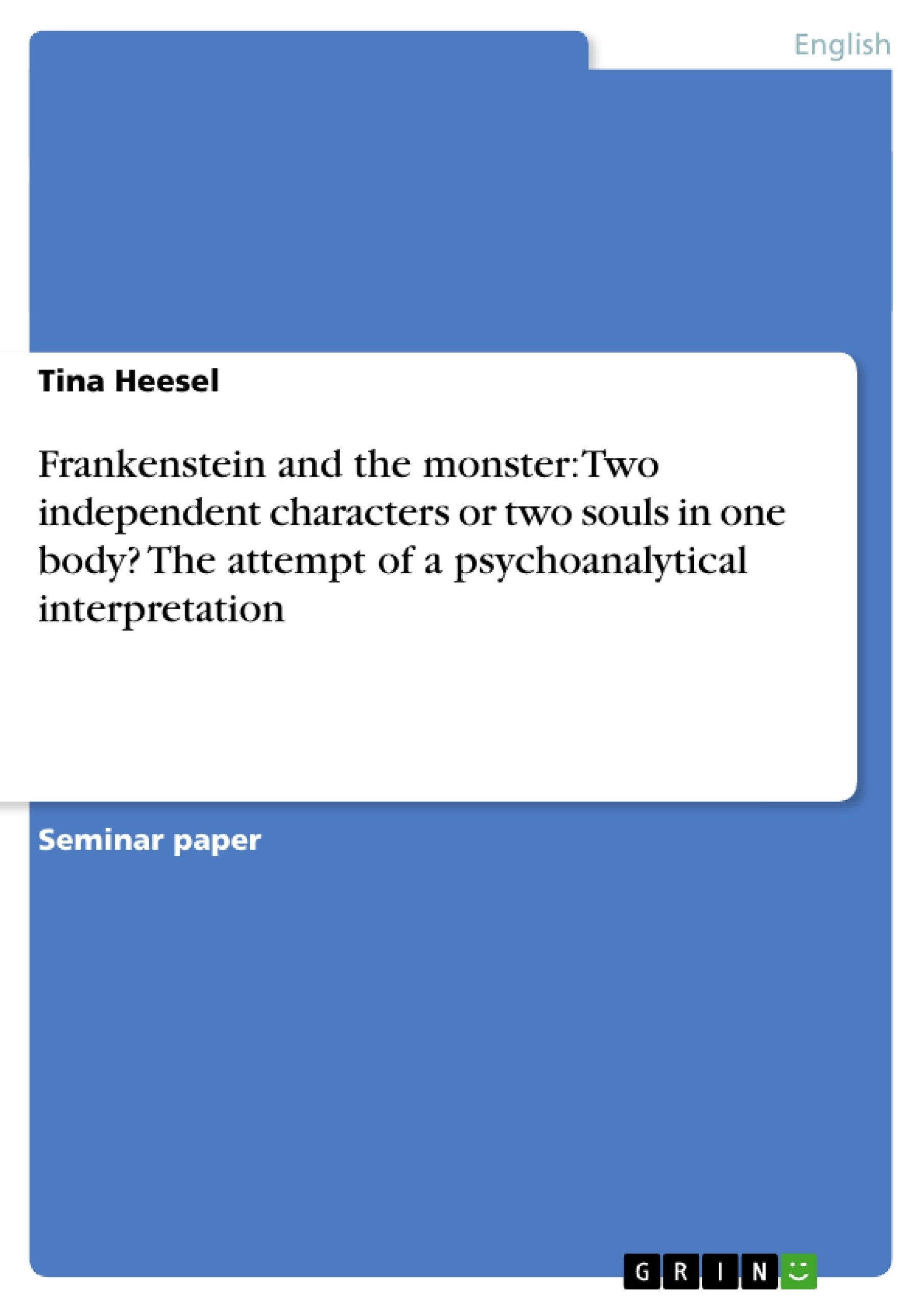This essay deals with Mary Shelley´s “Frankenstein”. People who do not know the book but only its title often associate the name Frankenstein with the monster. Why do many people think that Frankenstein is the monster?
The question to be discussed in this essay is if Victor and the monster are both single and independent characters or if the monster can be described as Victor Frankenstein´s double.
This essay is the attempt to interpret the book from a psychoanalytical point of view. The analysis refers to the major works of Sigmund Freud.
At first I describe and explain some basic knowledge of Sigmund Freud, such as his model of personality or rather the mental apparatus with its three organisational units ID, EGO and SUPEREGO. After that I name some tools the EGO can use, called Ego Defence Mechanisms, but this is only done very generally. The human drives have to be mentioned and explained because they are very important for the question to be discussed. Because Victor Frankenstein´s life is analysed chronologically the psychosexual development has to be referred to, too. Last but not least Freud´s conception of the human psyche is mentioned and explained. It is important to say that I always refer to Freud when speaking about psychoanalytical expressions in this essay, even when they are not always named as those.
After the explanation of the psychoanalytical basic knowledge which is important for this essay I start the analysis of Victor Frankenstein´s life. As mentioned before, this is done chronologically: from the time of his birth to his death. The different stations in his life are shortly summarized and afterwards analysed and psychoanalytically interpreted in a very detailed way. There are many quotes from the text because it is not possible to prove some claims without referring to the text.
At the end of the analysis I summarize the most important results. After that I shortly discuss these results critically and give possible alternatives.
Inhaltsverzeichnis (Table of Contents)
- Introduction
- Psychoanalytical basic knowledge
- Freud's model of personality – the mental apparatus
- Ego Defence Mechanism
- Human drives
- The psychosexual development
- The topographical Model
- Psychoanalytical basic knowledge
- Analysis of the text
- Victor's earliest childhood
- Victor's youth and puberty
- Victor's departure to Ingolstadt
- Victor's studies and his plan to create a human body
- The birth of the monster
- Victor's first collapse
- The positive development of the monster
- Victor's apparent recovery
- The Creature´s development to a real monster
- The letter of the father
- Justine's execution
- Victor's longing for revenge
- Victor's departure to the Alpine valleys
- A companion for the monster
- The revenge of the monster
- Victor's homecoming
- The wedding- night
- The final hunting
- Conclusion
Zielsetzung und Themenschwerpunkte (Objectives and Key Themes)
This essay examines Mary Shelley's "Frankenstein" from a psychoanalytical perspective, primarily focusing on the relationship between Victor Frankenstein and the monster. It explores whether they are independent characters or if the monster can be considered Victor's double.
- Analysis of Victor Frankenstein's character through the lens of Freud's psychoanalytical theories
- Exploration of the nature of the monster and its relationship with Victor
- Examination of the role of the subconscious and unconscious drives in shaping both Victor's and the monster's actions
- Investigation of the concept of duality and the idea of a double in the context of the novel
- Discussion of the implications of psychoanalytical interpretation for understanding "Frankenstein"
Zusammenfassung der Kapitel (Chapter Summaries)
- Introduction: This chapter introduces the topic of the essay, explaining the question of whether Victor and the monster are independent characters or doubles, and outlines the use of Freudian psychoanalytical theory for interpreting the text. It also provides a brief overview of key psychoanalytical concepts that will be utilized in the analysis.
- Psychoanalytical basic knowledge: This chapter delves into Freud's model of personality, explaining the three organisational units: ID, EGO, and SUPEREGO. It discusses the Ego Defence Mechanisms, human drives (Eros and Thanatos), and the concept of libido, destrudo, narcissism, and fixation. The chapter also outlines Freud's theory of psychosexual development and the stages of oral, anal, and phallic.
- Analysis of the text: This section begins the chronological analysis of Victor Frankenstein's life, starting from his birth and progressing through different stages, including his childhood, youth, studies, the creation of the monster, and subsequent events.
Schlüsselwörter (Keywords)
The primary keywords and concepts within this essay include: "Frankenstein," "monster," "psychoanalysis," "Sigmund Freud," "ID," "EGO," "SUPEREGO," "Ego Defence Mechanisms," "human drives," "libido," "destrudo," "narcissism," "fixation," "psychosexual development," "duality," and "double." The essay focuses on exploring the complexities of Victor Frankenstein's character and his relationship with the monster through the lens of Freudian theory, aiming to uncover the underlying psychological motivations and dynamics that drive their actions.
- Arbeit zitieren
- Tina Heesel (Autor:in), 2005, Frankenstein and the monster: Two independent characters or two souls in one body? The attempt of a psychoanalytical interpretation , München, GRIN Verlag, https://www.hausarbeiten.de/document/78493


